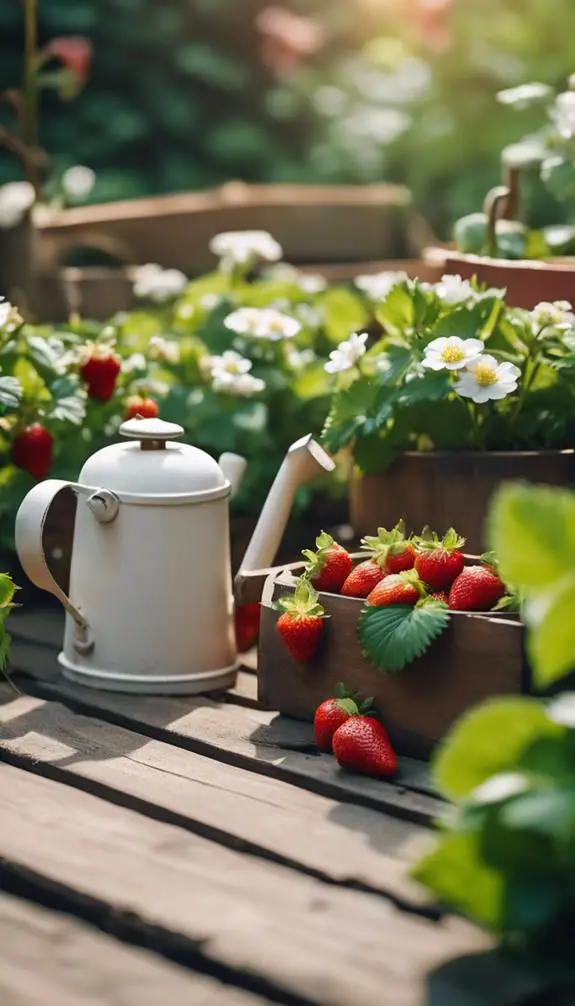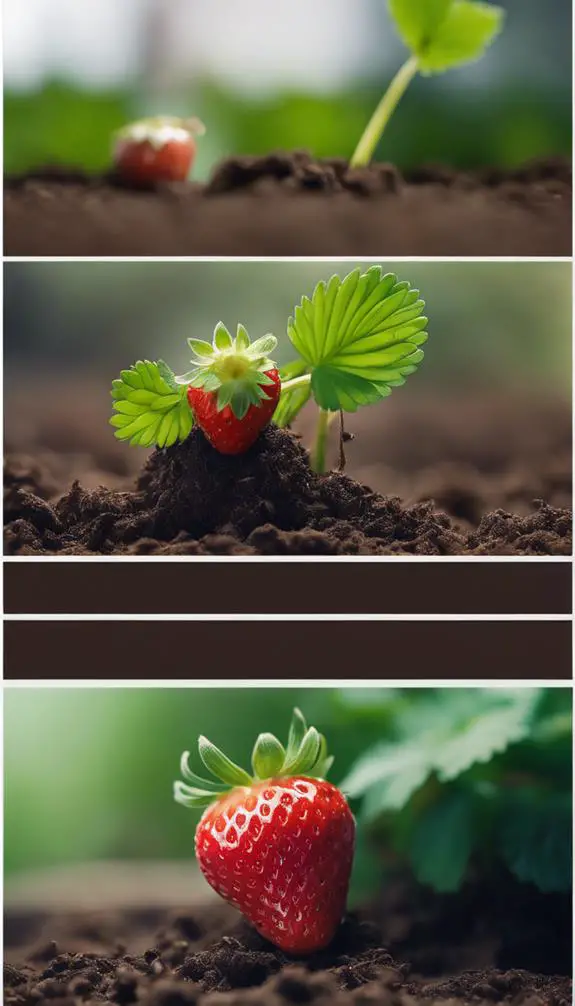As you set out on growing sweet peppers from seeds, you're likely enthusiastic to harvest those crunchy, juicy fruits in no time. To set yourself up for success, it's vital to start with the right foundation. You'll need to choose the perfect variety, prep the soil to meet the seeds' specific needs, and create an environment that fosters germination. But that's just the beginning – there's more to it than just sowing seeds and waiting for them to sprout. You'll need to provide the right conditions for your seedlings to thrive, and that's where the real challenge begins.
Summary
- Select sweet pepper seeds based on days to maturity, fruit size, and heat level to ensure a successful harvest.
- Prepare soil by testing pH levels, adding organic matter, and balancing nutrients to create a fertile growing environment.
- Sow seeds indoors 6-8 weeks before the last frost date or directly outdoors in areas with a long growing season, maintaining ideal soil temperature and humidity.
- Provide seedlings with consistent light exposure, regulated temperature, and careful watering to promote healthy growth and avoid root rot.
- Transplant seedlings outdoors after hardening off, and maintain consistent sunlight, temperature, and watering schedules to support fruit production.
Choosing the Right Sweet Pepper Seeds

When selecting sweet pepper seeds, you're not just choosing a variety – you're determining the flavor, texture, and overall success of your harvest.
With hundreds of pepper varieties available, it's crucial to understand the characteristics you're looking for. Consider factors like days to maturity, fruit size, and heat level to guarantee you're getting the right seeds for your climate and desired outcome.
Bell peppers, for example, are sweet and crunchy, while hot peppers like jalapeños add a spicy kick. Some varieties, like sweet mini peppers, are ideal for snacking, while others, like Anaheim peppers, are better suited for cooking.
Preparing the Soil for Sowing

Your soil is the foundation of a successful sweet pepper crop, and its preparation is critical to giving your seeds the best possible start.
Before sowing, you'll want to test your soil to determine its pH level and nutrient composition. This information will help you make informed decisions about amendments and fertilizers.
If your soil test reveals an imbalanced pH, don't worry – pH balancing is a straightforward process. For sweet peppers, aim for a slightly acidic to neutral soil pH, ranging from 6.0 to 7.0.
Based on your soil test results, add lime to raise the pH or elemental sulfur to lower it. Once you've achieved ideal pH levels, you can focus on adding organic matter and nutrients to create a fertile growing environment for your sweet pepper seeds.
Sowing Seeds Indoors or Outdoors

Sowing seeds indoors or outdoors requires careful consideration of factors such as climate, available space, and desired harvest timing.
You'll need to decide whether to sow seeds directly into the garden or start them indoors in pots or cells. If you live in an area with a long growing season, direct sowing may be the best option.
However, if your region has a short growing season or cool soil temperatures, starting seeds indoors 6-8 weeks before the last frost date can give them a head start.
When sowing, plant seeds at a depth of ¼ inch and maintain a soil temperature between 75°F and 85°F for ideal germination.
Creating the Ideal Germination Environment

As you prepare to sow your sweet pepper seeds, you'll want to focus on crafting an environment that fosters ideal germination.
To achieve this, you'll need to control humidity levels, maintaining a consistent 70-80% relative humidity. This can be done using a propagation tray with a clear plastic dome or a cloche.
Next, provide the perfect light spectrum for germination. Sweet peppers require a low to moderate light intensity, with a spectrum leaning towards the blue end (400-500 nm).
This can be achieved using LED grow lights or placing the seeds near a sunny windowsill with a sheer curtain filter. By controlling humidity and light spectrum, you'll create an ideal environment for your sweet pepper seeds to germinate.
Caring for Seedlings After Germination

Once germination occurs, step up the care for your sweet pepper seedlings to guarantee they develop strong roots and sturdy stems.
You'll need to maintain a consistent seedling schedule, ensuring 12-14 hours of light exposure daily. Provide supplemental lighting if necessary, as sweet peppers require intense light to thrive.
Microclimate maintenance is vital; regulate temperature between 65-75°F (18-24°C) and maintain humidity levels above 50%.
Water carefully, as overwatering can lead to root rot. Water only when the top 1-2 inches of soil feel dry to the touch.
Monitor your seedlings closely, and adjust your care routine as needed to promote healthy growth. By following these guidelines, you'll set your sweet peppers up for success.
Transplanting Seedlings Outdoors

You're now ready to transfer your seedlings from indoor pots to outdoor beds.
Before doing so, you'll need to harden off your seedlings to prepare them for outdoor conditions, and verify the soil is well-prepared to support their growth.
Proper timing is also vital, as transplanting at the right moment will give your sweet peppers the best chance to thrive.
Hardening Off Process
Vulnerability to stress and disease lurks in every seedling, waiting to pounce when it's transplanted outdoors.
To mitigate this risk, you'll need to harden off your sweet pepper seedlings. This process involves weather acclimation through gradual exposure to outdoor conditions.
Start by moving your seedlings to a shaded area outdoors for 2-3 hours a day, returning them to a protected spot at night. Over the next 7-10 days, gradually increase their outdoor exposure, adding 1-2 hours daily.
This will allow your seedlings to adapt to direct sunlight, wind, and temperature fluctuations. By hardening off your seedlings, you'll substantially reduce the risk of shock and disease, ensuring a smooth shift to outdoor growth.
Outdoor Soil Preparation
With your hardening-off process complete, it's time to prepare the outdoor soil for transplanting your sweet pepper seedlings.
Before transplanting, conduct a soil test to determine the pH level and nutrient content of your soil. Based on the test results, add organic matter like compost to adjust the pH and provide essential micronutrients.
Verify the compost quality is high, with a mix of "green" materials like food waste and "brown" materials like dried leaves. Aim for a well-balanced compost that's rich in humus, which will improve soil structure and water retention.
Ideal Transplant Timing
Timing the transplant of your sweet pepper seedlings outdoors is critical, as it directly impacts their growth and development.
You'll want to wait until the danger of frost has passed and the soil has warmed up to at least 60°F (15°C). This is usually 1-2 weeks after the last frost date in your area.
Transplanting too early can lead to transplant shock, causing seedling stress and stunted growth. Make sure to harden off your seedlings by gradually exposing them to outdoor conditions over the course of 7-10 days before transplanting.
This will help minimize shock and certify a successful shift to outdoor growth. By timing your transplant correctly, you'll set your sweet peppers up for prime growth and a bountiful harvest.
Providing Optimal Sunlight and Temperature

Located in a spot that receives direct sunlight for at least six hours a day, sweet pepper plants thrive when exposed to ideal sunlight conditions.
You'll want to guarantee the sunlight duration is consistent, as fluctuations can impact plant growth. Aim for direct sunlight during the morning hours when the sun is gentler, and provide shade during the hottest part of the day to prevent scorching.
Temperature fluctuations can also affect sweet pepper growth.
You'll want to maintain a consistent temperature between 65°F to 75°F (18°C to 24°C) during the day and no lower than 55°F (13°C) at night.
Avoid placing plants near heating or cooling vents, fireplaces, or drafty windows to minimize temperature fluctuations.
Watering and Fertilizing Sweet Peppers

You'll need to guarantee your sweet pepper plants receive the right amount of water, as inconsistent moisture levels can lead to disease and reduced yields.
Sweet peppers require about 1-2 inches of water per week, either from rainfall or irrigation.
Additionally, you'll need to provide your plants with essential nutrients, such as nitrogen, phosphorus, and potassium, to support healthy growth and fruit production.
Water Requirements
About one inch of water per week is ideal for sweet peppers, which translates to around 20-25 gallons of water per plant per week.
You'll want to monitor moisture levels to guarantee the soil is consistently moist but not waterlogged. Check the water tables regularly to avoid overwatering, which can lead to root rot and other issues.
You can also use a drip irrigation system or soaker hose to deliver water directly to the roots, reducing evaporation and runoff. Aim to provide a steady supply of water, rather than flooding the soil with infrequent deep waterings.
Soil Nutrient Needs
As sweet peppers grow, they deplete the soil of essential nutrients, making fertilization a crucial step in their development.
You'll need to certify your soil provides the necessary nutrients for peak growth. Conduct soil tests to determine any nutrient deficiencies, which can severely impact pepper yield and quality.
Common deficiencies include nitrogen, phosphorus, and potassium. Based on your soil test results, apply balanced fertilizers that address these deficiencies.
Aim for a fertilizer with a balanced N-P-K ratio, such as 10-10-10. Additionally, consider adding organic matter like compost or manure to improve soil structure and fertility.
Supporting Pepper Plants as They Grow
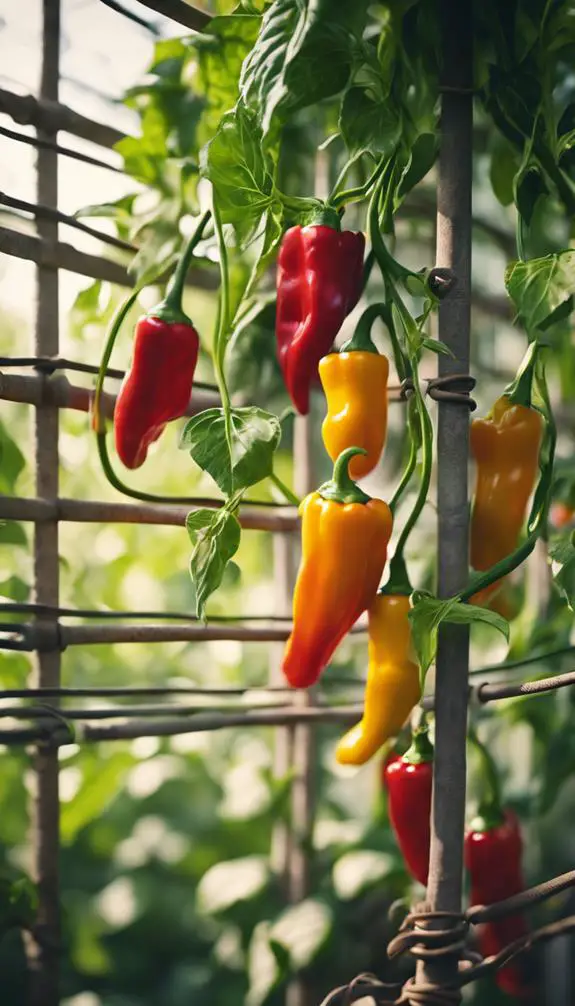
Several sweet pepper varieties can grow quite large, producing dozens of fruit, and will require support to prevent them from toppling over in the wind or under the weight of their own production.
You'll need to provide a sturdy structure for them to climb on. Pepper trellises are an excellent option, allowing you to train the vines to grow upwards, keeping the fruit off the ground and promoting better air circulation.
Alternatively, you can use sturdy stakes, placed near the base of the plant, to provide individual support. Make sure to tie the stems gently but securely to the stake using twine or clips. This will keep your pepper plants upright and stable, ensuring a healthy and productive harvest.
Pruning for Better Fruit Production

How can you encourage your sweet pepper plants to produce a bountiful harvest?
Pruning is a vital step in promoting fruit production. By using effective pruning techniques, you'll stimulate your plants to focus energy on fruit growth rather than foliage.
Remove lower leaves to prevent fungal diseases and encourage air circulation. Pinch off weak growth to direct the plant's energy towards strong, fruit-bearing branches.
Fruitful pruning involves cutting back the terminal bud to encourage bushy growth and more fruiting sites. This technique will result in a more compact plant with increased fruit production.
Managing Pests and Common Diseases
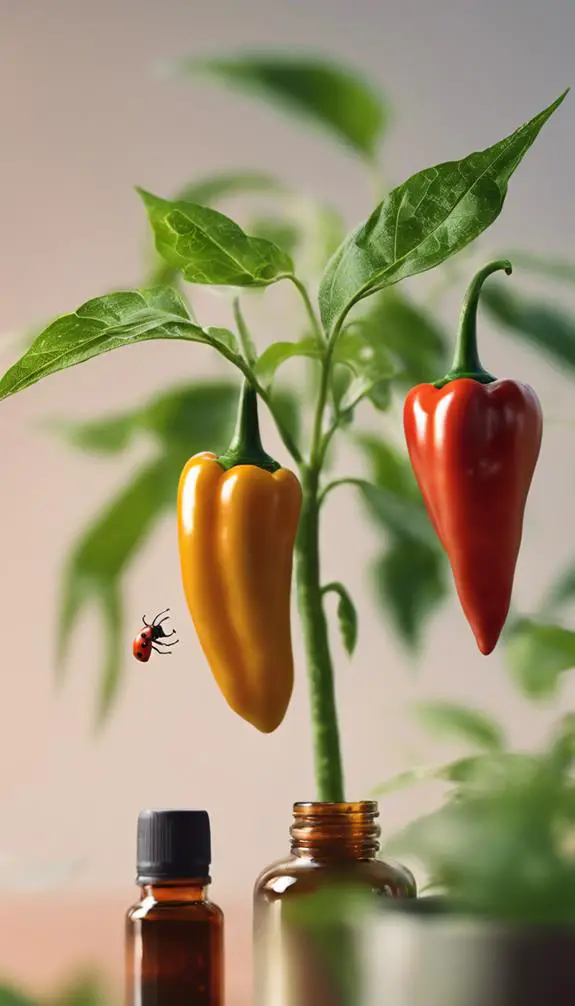
You'll need to be vigilant about managing pests and diseases in your sweet pepper patch, as they can quickly decimate your crop.
Effective pest control methods, such as introducing beneficial insects and using organic repellents, will help you ward off common pests like aphids and whiteflies.
Pest Control Methods
When sweet pepper crops are thriving, pests and diseases can swoop in, decimating yields and leaving growers frustrated.
You'll need to act quickly to manage these pests and prevent damage. Natural deterrents like neem oil, garlic, and hot pepper sprays can repel pests without harming the environment.
You can also use organic pesticides like pyrethrin and rotenone to control infestations. Introduce beneficial insects like ladybugs and lacewings, which prey on pests, into your garden.
Guarantee good garden hygiene by removing weeds, debris, and infested plants to prevent the spread of pests. Monitor your plants regularly, and take action at the first sign of pest activity.
Common Sweet Pepper Diseases
Sweet pepper diseases can be just as destructive as pests, causing significant damage and reducing yields.
You'll want to keep an eye out for fungal infections like powdery mildew and leaf spot, which can spread quickly and destroy your crop.
Bacterial blights, such as bacterial leaf spot and fire blight, can also wreak havoc on your sweet pepper plants.
These diseases often spread through contaminated soil, water, or infected plant debris.
To prevent the spread of disease, make sure to remove and dispose of infected plants, sanitize your tools and equipment, and maintain good air circulation around your plants.
Regularly inspect your plants for signs of disease, and take action quickly to prevent the disease from spreading.
Pollination and Fruit Development

Pollination sets the stage for fruit development, as it triggers a series of biochemical reactions that ultimately lead to the formation of sweet peppers.
To guarantee successful pollination, you'll want to attract pollinators like bees and butterflies to your plants. This can be achieved through pollinator attraction techniques such as providing a diverse range of flowers, using companion planting, and maintaining a clean and healthy garden environment.
Once pollination occurs, you'll notice fruit setting on your plants. It's vital to implement fruit thinning practices to promote healthy growth and development. This involves removing weaker fruit to allow the stronger ones to receive more nutrients and sunlight, resulting in larger, sweeter peppers.
Harvesting Sweet Peppers at the Right Time
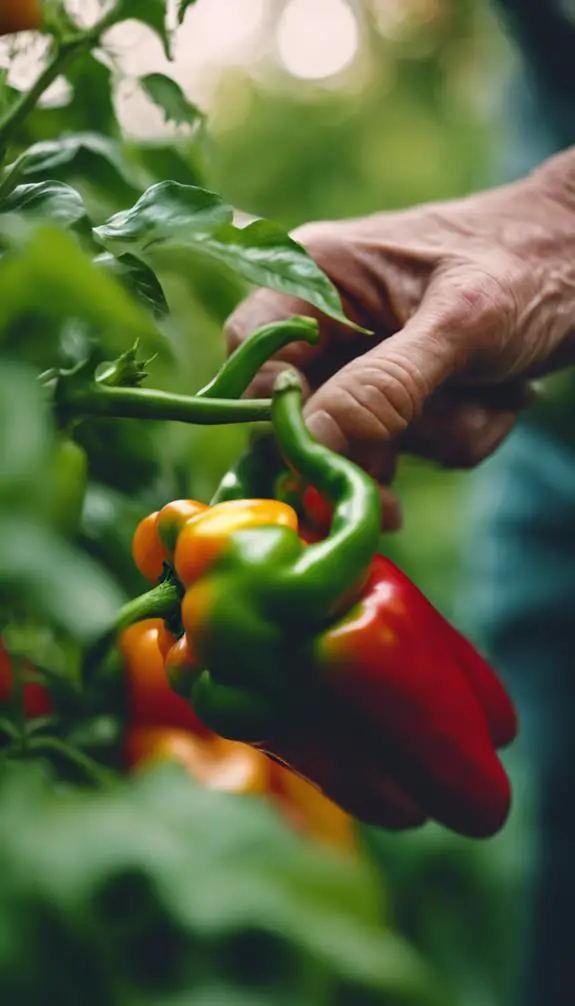
Upon inspecting your pepper plants, you'll notice the fruit has transformed from a vibrant green to a kaleidoscope of colors, signaling their readiness for harvest.
This pepper color variation is a key indicator of sweet pepper ripeness. Yellow, orange, red, and even purple hues will emerge, depending on the specific sweet pepper variety.
To guarantee prime flavor and texture, harvest sweet peppers when they're fully ripe. Check for ripeness by gently tugging on the pepper; a ripe pepper will come off the plant easily.
Avoid squeezing or pulling too hard, as this can damage the plant or pepper. Regular harvesting will encourage your plants to produce more fruit, increasing your overall yield.
FAQs
Can I Grow Sweet Peppers in Containers on My Balcony?
You can grow sweet peppers in containers on your balcony if you provide ideal balcony conditions, such as full sun, warm temperatures, and consistent moisture, and choose a container size that's at least 5-gallons with good drainage.
Do Sweet Peppers Need to Be Rotated Every Season?
You'll want to rotate your sweet peppers every season to avoid soil depletion, a common issue with continuous cropping, and promote healthy growth; crop rotation breaks disease and pest cycles, ensuring a more resilient and productive harvest.
Can I Use a Heating Mat for Faster Germination?
You can definitely use a heating mat to speed up germination, as it maintains a consistent soil temperature, typically between 75-85°F, ideal for seed germination, allowing you to achieve faster and more uniform results.
Will Sweet Peppers Grow in Partial Shade?
You'll find that sweet peppers have moderate shade tolerance, requiring at least 4-6 hours of direct sunlight. However, they'll thrive in areas with high light intensity, so if you can't provide full sun, guarantee partial shade doesn't dip below 50% shade.
Can I Save Seeds From My Harvested Sweet Peppers?
You can save seeds from your harvested sweet peppers, but guarantee proper processing and storage to maintain seed viability. Be aware of potential cross-pollination effects, which may impact seed quality and future plant performance.
Conclusion
You've successfully grown sweet peppers from seeds. Now, enjoy the fruits of your labor! Monitor your plants' progress, addressing any issues promptly. With proper care, your sweet peppers will thrive, providing a bountiful harvest. Remember to harvest them at the right time to guarantee peak flavor and texture. By following these guidelines, you'll be enjoying crunchy, sweet, and delicious homegrown peppers in no time.


